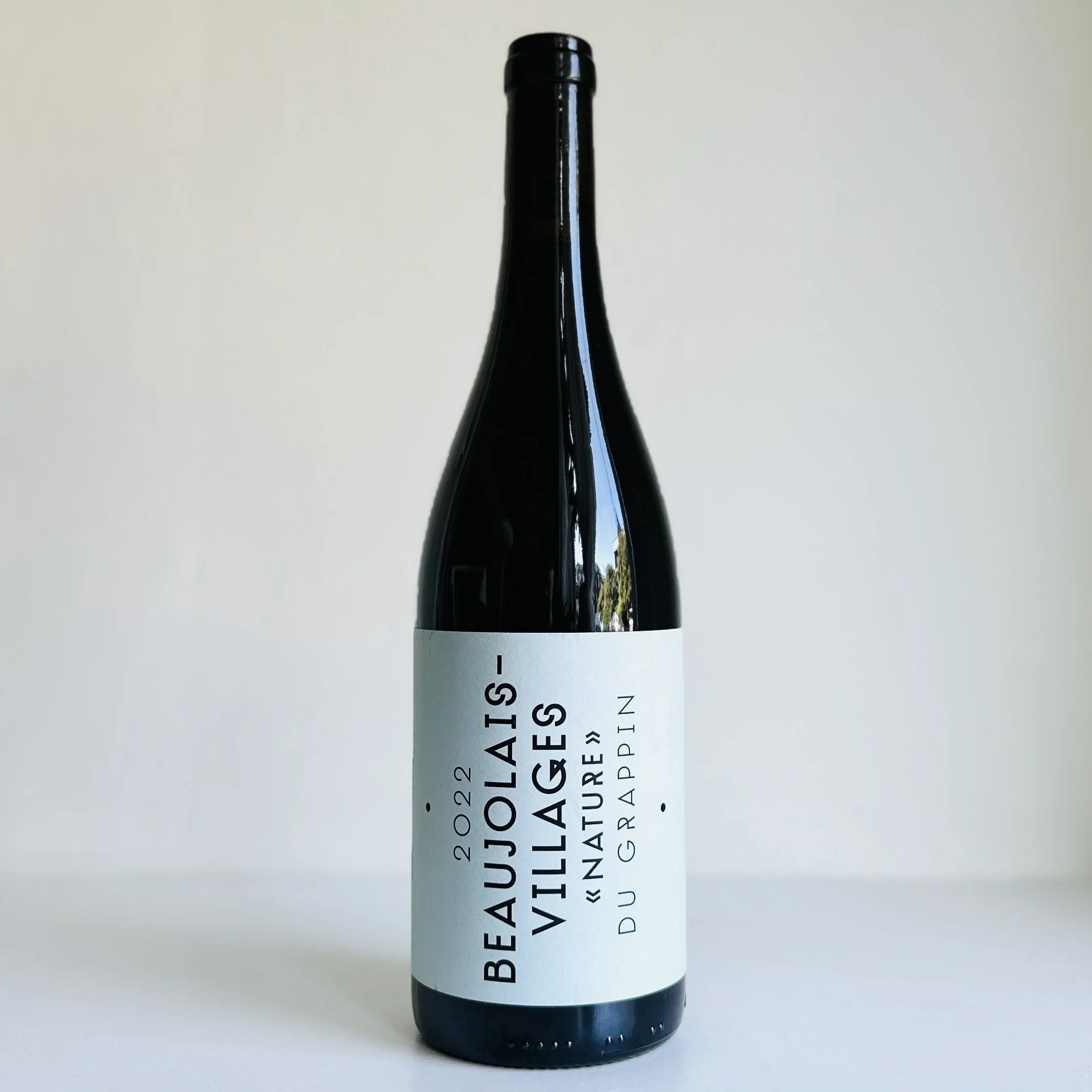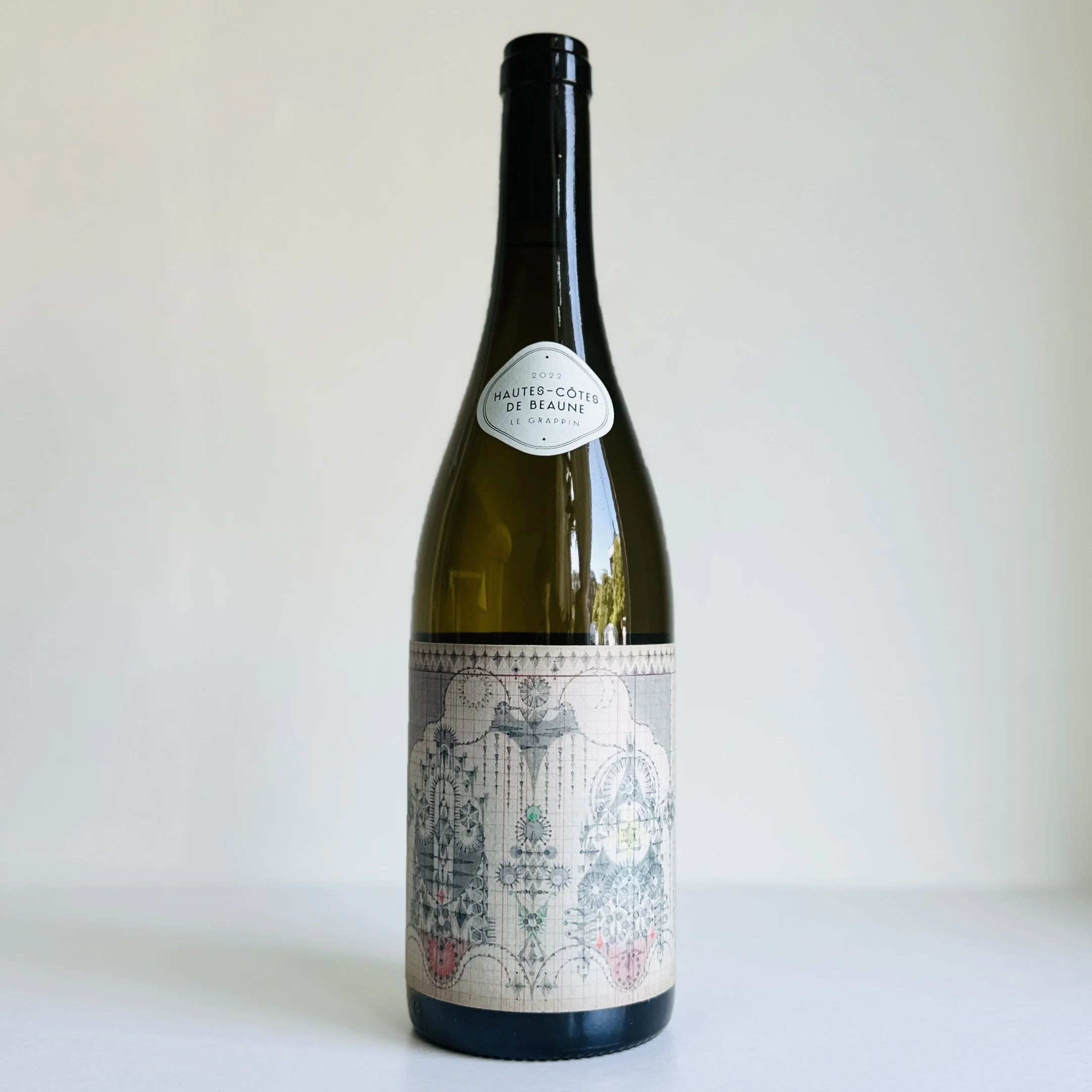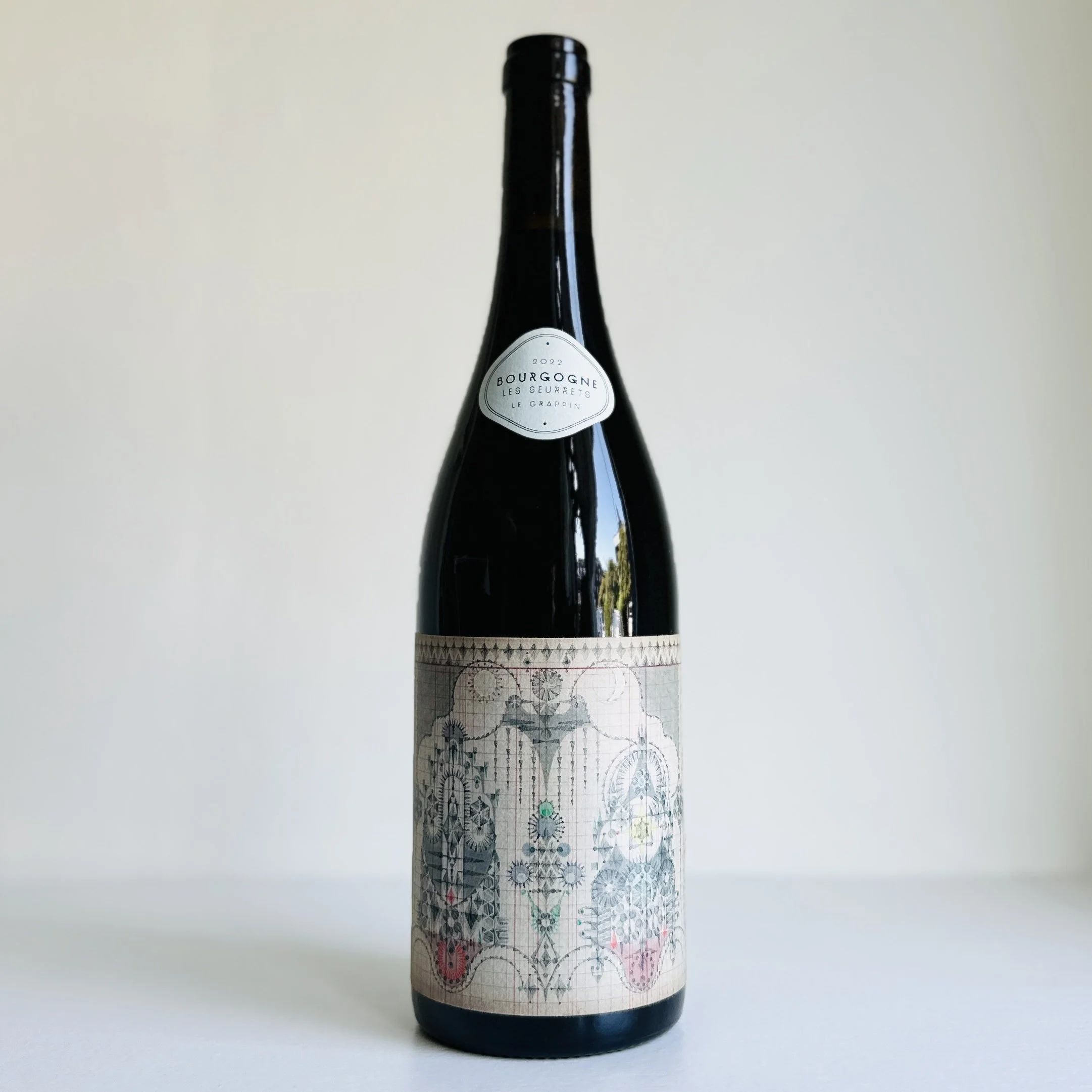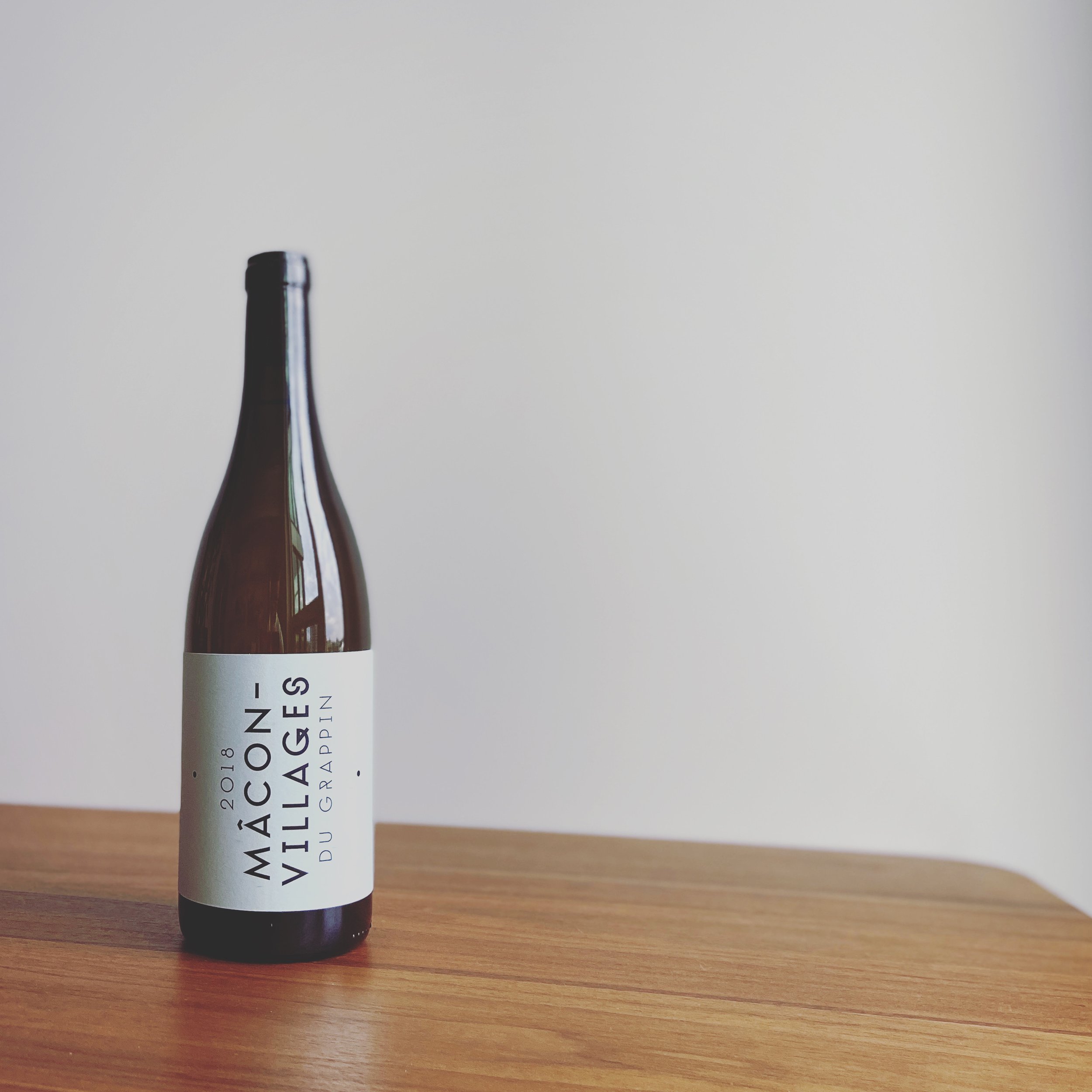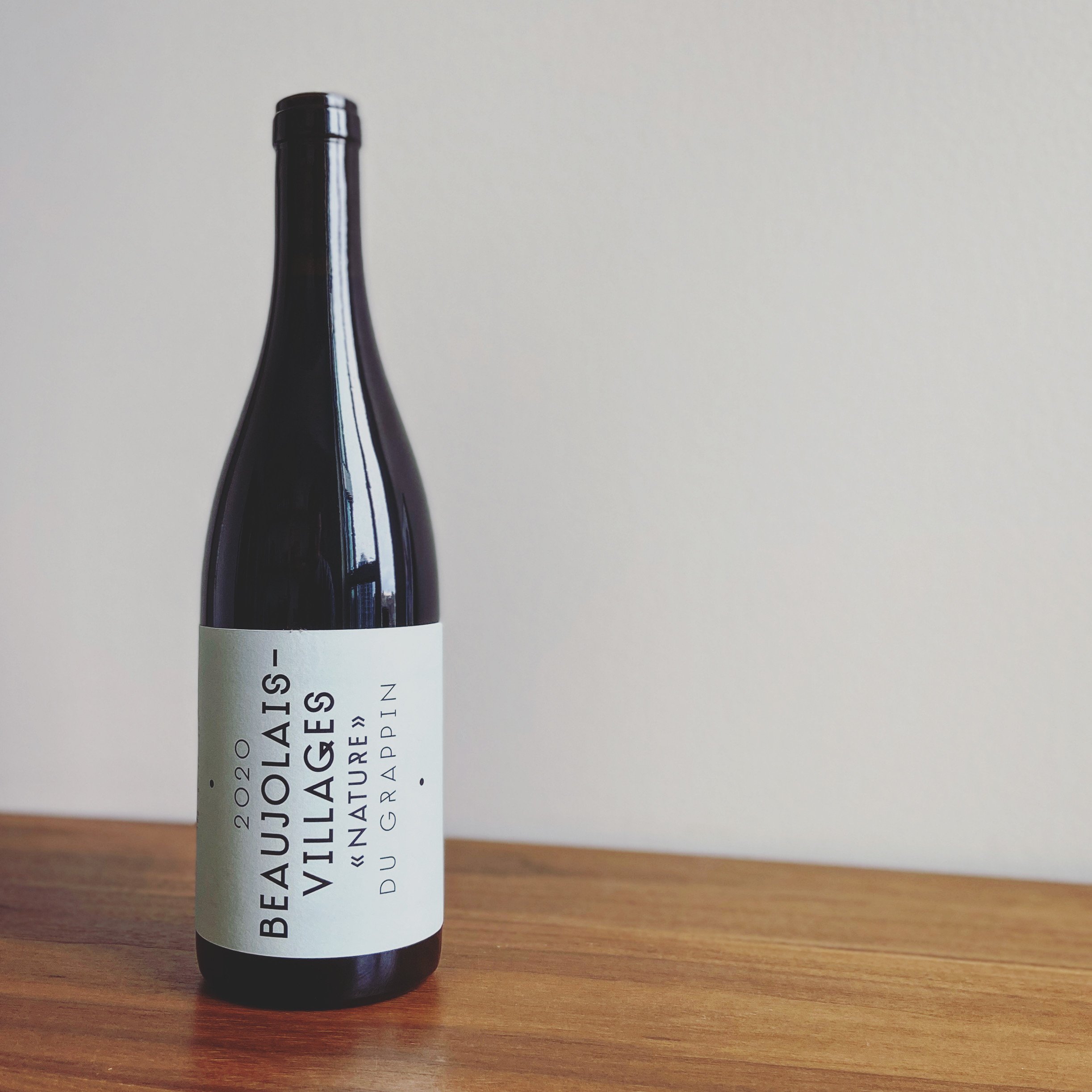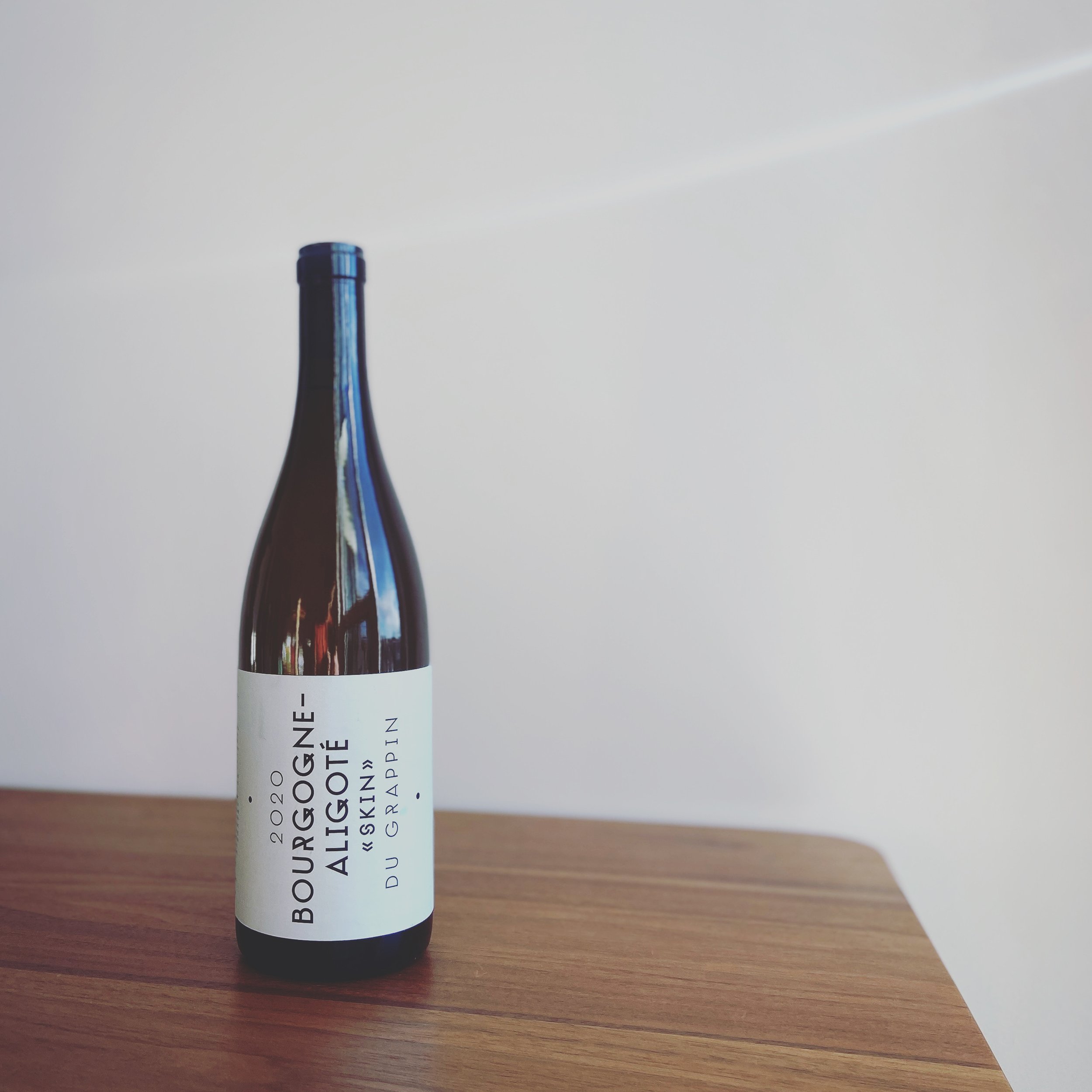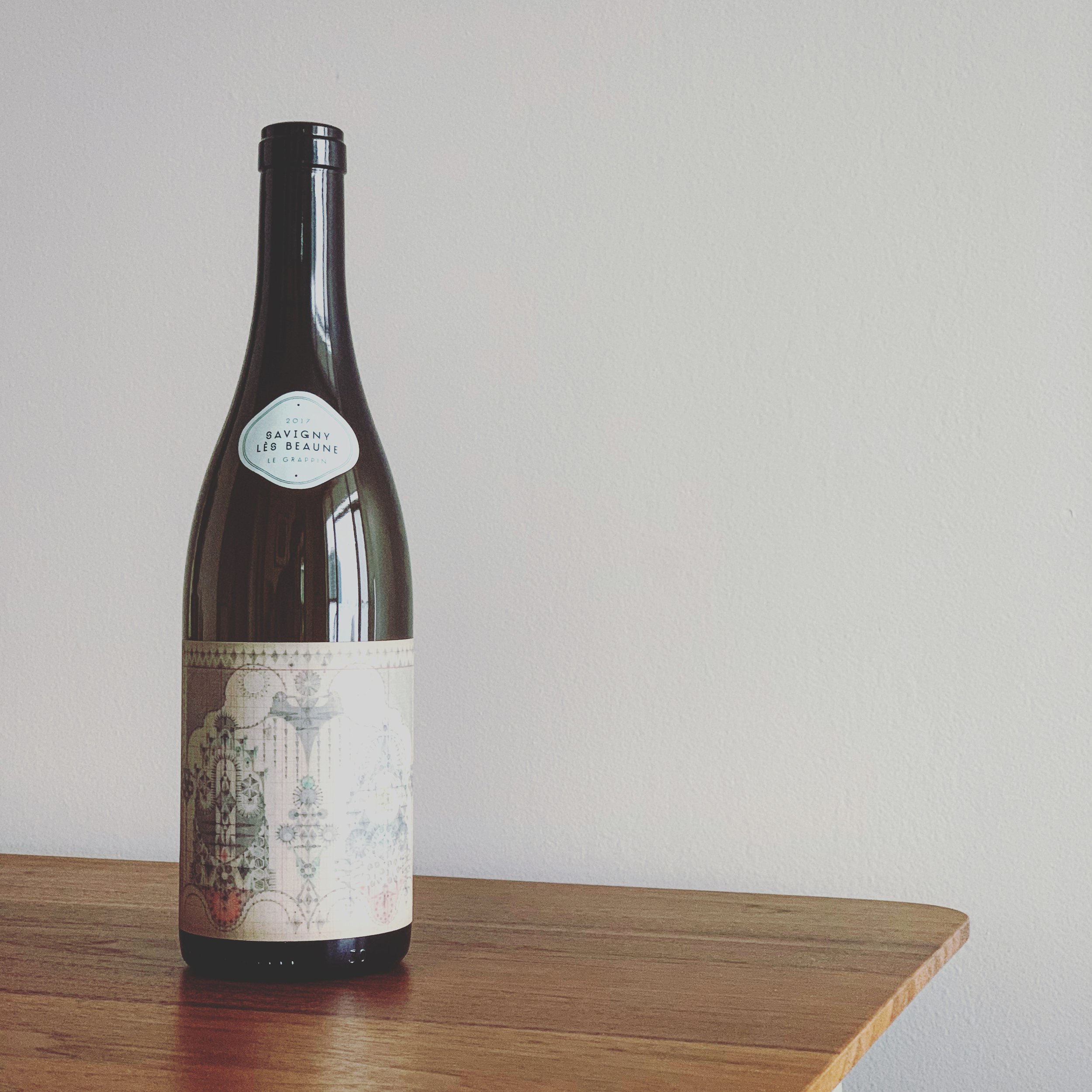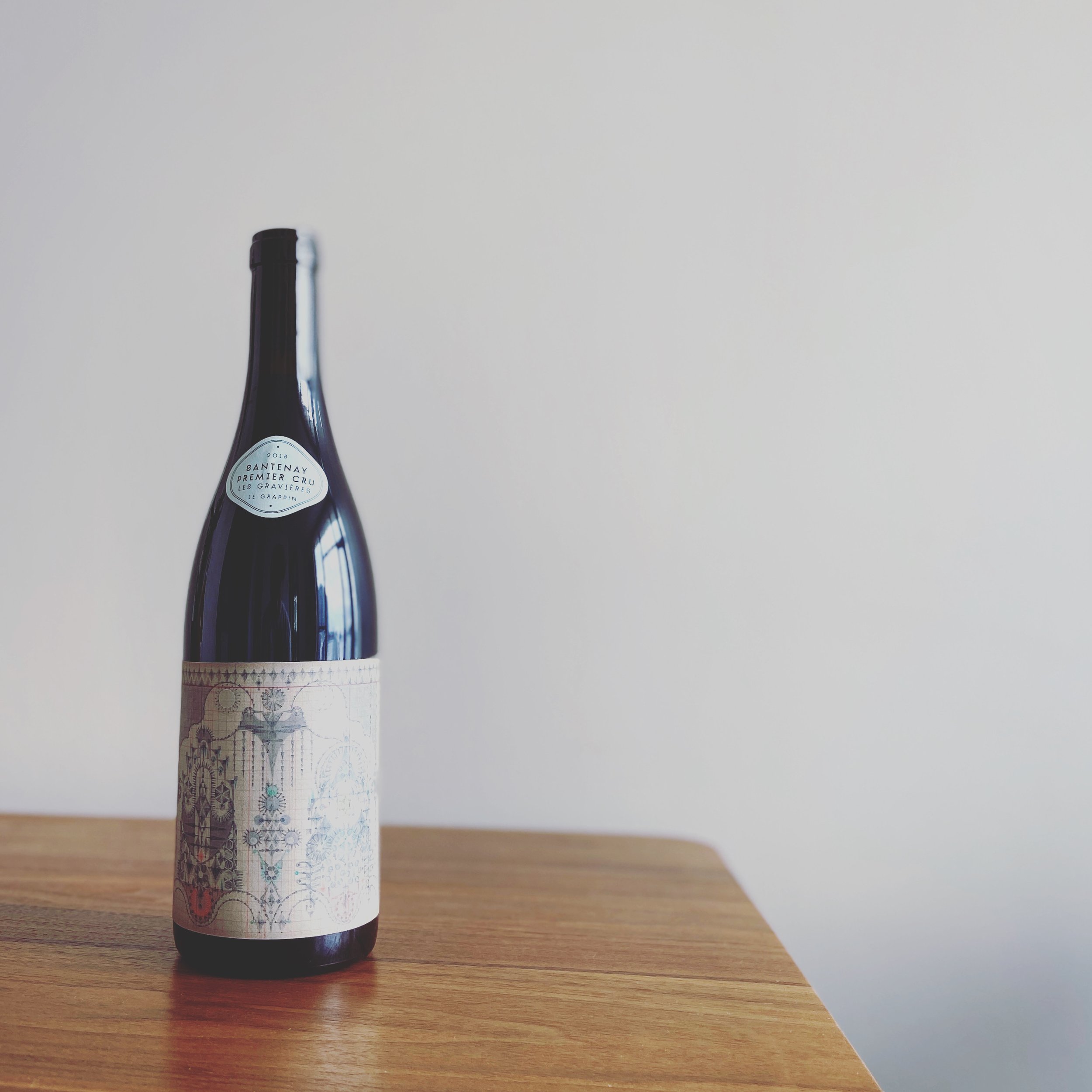LE GRAPPIN
PAST WINES
2022 BEAUJOLAIS-VILLAGES
Lancié, adjacent to Fleurie, is considered by some to be the forgotten cru of Beaujolais. This cuvées comes from fifty-year-old gobelet trained vines deeply rooted into alluvial pink granite and schist on a southeast-facing slope beneath the village itself. The grapes were fermented whole-cluster in concrete for ten days before being pressed off into tank and foudre for a nine-month elevage. It is bottled unfined and unfiltered, typically without SO2., under Diam corks for consistency.
2022 HAUTES-COTES DE BEAUNE BLANC
Perched behind Auxey-Duresses, the lieu dit Derrière Baubigny can be found below the town of Ochre. Forty year old vines benefit from the southeast exposure and limestone and mica soils – a fossil hunter’s dream. The grapes are whole cluster pressed into foudre and old barrel for both fermentation and élevage. After a full year on lees the wine is racked and lightly filtered for bottling. 225 cases were produced.
2022 COTE D’OR ROUGE
This new cuvée comes from a vineyard below the town of Pommard. The lieu-dit of Les Seurrets features old vines planted on dolomitic alluvial marls and coarse limestone. Since it typically gives powerful wines, Andrew mitigated the weight by fermenting whole clusters in concrete for two weeks, minimizing extraction. It was then basket pressed into old foudre for a year of élevage. 325 cases were bottled unfined and unfiltered.
2021 MÂCON-VILLAGES
South of Uchizy, and North of Pouilly-Fuissé, this plot of thirty-year-old Chardonnay is in the town of Azé. Soils here are a combination of limestone and clay. The grapes were harvested in early September and were pressed into stainless steel without any added SO2. After a short cold settling to eliminate the gross lees, the juice was moved into 350L and 400L barrels. After seven months on fine lees without batonnage, the wine is lightly filtered and bottled.
2021 BEAUJOLAIS FLEURIE-PONCIÉ
This vineyard is planted on a ridge high above the village of Fleurie. This warm south-facing site tends to yield wines with similarities to Moulin-a-Vent. Being a traditionalist, Andrew used Jules Chauvet’s vintage notes from 1972 as winemaking inspiration. The wine is fermented whole-cluster for three weeks before being pressed off into neutral foudres. No crushing, pumping, or plunging was performed during this time. The wine is unfined and unfiltered.
2021 BEAUNE 1er CRU LES BOUCHEROTTES
Boucherottes is a lieu-dit located beneath Clos des Mouches and next to Pommard’s Les Epenots. Part of the plot is 40-year-old selection massale while the other component is Dijon 114/115. The grapes are fermented in nearly equal parts whole cluster and destemmed. After fermentation the wine is settled in tank before being racked to 300L barrel for eleven months. The wine is bottled, unfined and unfiltered under DIAM 10 corks to prevent spoilage and ensure consistency.
2021 SAVIGNY-LES-BEAUNE ROUGE
The Pinot Noir for this cuvée was grown in a small lieu-dit called Aux Fournaux. The sixty-year-old vines are at the bottom of the slope adjacent to Vergelesses and Lavieres. Soils are comprised to Bathonian marl and limestone. The grapes are cooled over night before being moved to open-top vat. 30% of the grapes were destemmed. After pressing, the wine finishes its fermentation in tank before being racked into 300L barrel for eleven months. Limited new wood was used. The wine is bottled, unfined and unfiltered under DIAM 10 corks to prevent spoilage and ensure consistency.
2020 SAINT-AUBIN BLANC
This wine comes from the plot of En l’Ebaupin above the village of Saint Aubin. There is a soft gradient between chalky Argovian soils at the top of the slope, to iron rich Callovian lime-marl near the bottom of the slope. It’s westerly slope beneath the Haut-Cote delays ripening. The grapes are gently pressed for three hours and allowed to settle overnight. After a day of oxidation, the wine is racked into 300-400L barrel for fermentation and élevage. The wine is bottled, unfined and unfiltered under DIAM 10 corks to prevent spoilage and ensure consistency.
2020 MONTAGLY 1er CRU LES TREUFFÈRES BLANC
These forty-year-old Chardonnay vines are located above the town of Buxy in a parcel called Les Treuffères in the Côte Chalonnaise. Soils here are an ideal mixture of limestone and clay on a south facing aspect. The grapes were whole cluster pressed before settling in tank and being racked into barrel for fermentation and élevage. 12% ABV
2020 MÂCON-VILLAGES
South of Uchizy, and North of Pouilly-Fuissé, this plot of thirty-year-old Chardonnay is in the town of Azé. Soils here are a combination of limestone and clay. The grapes were harvested in early September and were pressed into stainless steel without any added SO2. After a short cold settling to eliminate the gross lees, the juice was moved into 350L and 400L barrels. After seven months on fine lees without batonnage, the wine is lightly filtered and bottled.
2020 BEAUJOLAIS FLEURIE-PONCIÉ
This vineyard is planted on a ridge high above the village of Fleurie. This warm south-facing site tends to yield wines with similarities to Moulin-a-Vent. In an email exchange, Andrew was particularly excited about this cuvée. Being a traditionalist, Andrew used Jules Chauvet’s vintage notes from 1972 as winemaking inspiration. The wine is fermented whole-cluster for three weeks before being pressed off into neutral foudres. No crushing, pumping, or plunging was performed during this time. The wine is unfined and unfiltered.
2020 BEAUNE 1ER CRU BOUCHEROTTES ROUGE
Boucherottes is a lieu-dit located beneath Clos des Mouches and next to Pommard’s Les Epenots. Part of the plot is 40-year-old selection massale while the other component is Dijon 114/115. The grapes are fermented in nearly equal parts whole cluster and destemmed. After fermentation the wine is settled in tank before being racked to 300L barrel for eleven months. The wine is bottled, unfined and unfiltered under DIAM 10 corks to prevent spoilage and ensure consistency.
2020 SAVIGNY-LES-BEAUNE ROUGE
The Pinot Noir for this cuvée was grown in a small lieu-dit called Aux Fournaux. The sixty-year-old vines are at the bottom of the slope adjacent to Vergelesses and Lavieres. Soils are comprised to Bathonian marl and limestone. The grapes are cooled over night before being moved to open-top vat. 30% of the grapes were destemmed. After pressing, the wine finishes its fermentation in tank before being racked into 300L barrel for eleven months. Only 15% new wood was used. The wine is bottled, unfined and unfiltered under DIAM 10 corks to prevent spoilage and ensure consistency.
2020 BOURGOGNE ALIGOTÉ
This vineyard is in Mâcon La Roche-Vineuse on a south facing slope. The vines are over eighty years old and are planted in Bathonian limestone-marl. This biotype of Aligoté has orange-tinged skins. The grapes were foot crushed and then slowly basket pressed. Fermentation and élevage took place in old barrel before the wine was bottled unfined and unfiltered.
2019 BEAUJOLAIS FLEURIE-PONCIÉ
This vineyard is planted on a ridge high above the village of Fleurie. This warm south-facing site tends to yield wines with similarities to Moulin-a-Vent. In an email exchange, Andrew was particularly excited about this cuvée. Being a traditionalist, Andrew used Jules Chauvet’s vintage notes from 1972 as winemaking inspiration. The wine is fermented whole-cluster for three weeks before being pressed off into neutral foudres. No crushing, pumping, or plunging was performed during this time. The wine is unfined and unfiltered.
2020 BEAUJOLAIS-VILLAGES
Lancié, just south of Morgon and Fleurie, is considered by some to be the forgotten cru of Beaujolais. Fifty-year-old vines root deeply into alluvial pink granite on a south-east facing slope beneath the village itself. Whole clusters of Gamay Noir are kept under a protective layer of CO2 for intracellular fermentation (Carbonic Maceration). After a week, the grapes are pressed off into stainless steel and used Pinot Noir barrels to finish fermenting. After an additional five months on lees, the wine is bottled with minimal sulphur.
2020 BOURGOGNE ALIGOTÉ SKIN
This cuvée comes from the lieu dit of Perelles le Haut in the Mâcon. The vines are over 80-years-old, producing low yields of concentrated fruit. The grapes were fermented whole-cluster in a small tank for a week before being pressed off. The wine finishes fermentation in neutral barrel before a nine month élevage on full lees.
2019 MÂCON-VILLAGES
South of Uchizy, and North of Pouilly-Fuissé, this plot of thirty-year-old Chardonnay is in the town of Azé. Soils here are a combination of limestone and clay. The grapes were harvested in early September and were pressed into stainless steel without any added SO2. After a short cold settling to eliminate the gross lees, the juice was moved into 350L and 400L barrels. After seven months on fine lees without batonnage, the wine is lightly filtered and bottled.
2019 SAINT AUBIN BLANC
This wine comes from the plot of En l’Ebaupin above the village of Saint Aubin. There is a soft gradient between chalky Argovian soils at the top of the slope, to iron rich Callovian lime-marl near the bottom of the slope. It’s westerly slope beneath the Haut-Cote delays ripening. The grapes are gently pressed for three hours and allowed to settle overnight. After a day of oxidation, the wine is racked into 300-400L barrel for fermentation and élevage. The wine is bottled, unfined and unfiltered under DIAM 10 corks to prevent spoilage and ensure consistency.
2019 SAVIGNY-LES-BEAUNE ROUGE
The Pinot Noir for this cuvée was grown in a small lieu-dit called Aux Fournaux. The sixty-year-old vines are at the bottom of the slope adjacent to Vergelesses and Lavieres. Soils are comprised to Bathonian marl and limestone. The grapes are cooled over night before being moved to open-top vat. 30% of the grapes were destemmed. After pressing, the wine finishes its fermentation in tank before being racked into 300L barrel for eleven months. Only 15% new wood was used. The wine is bottled, unfined and unfiltered under DIAM 10 corks to prevent spoilage and ensure consistency.
2019 SANTENAY 1ER CRU ROUGE
This premier cru is located 100m away from Chassagne-Montrachet in the commune of Santenay. The vines are 45-70+ years old in the lieu-dit of Les Gravières. They are planted on extremely gravely soils created by runoff from the Saint Aubin Combe, over Argovian marl. The grapes were fermented in wooden tank under a blanket of CO2 for two weeks before two days of pigeage. The wine is then pressed off to tank to finish fermentation before it is racked into 300L barrel for a year long élevage. The wine was bottled unfined and unfiltered.
2019 BEAUNE 1ER CRU ROUGE
Boucherottes is a lieu-dit located beneath Clos des Mouches and next to Pommard’s Les Epenots. Part of the plot is 40-year-old selection massale while the other component is Dijon 114/115. The grapes are fermented in nearly equal parts whole cluster and destemmed. After fermentation the wine is settled in tank before being racked to 300L barrel for eleven months. The wine is bottled, unfined and unfiltered under DIAM 10 corks to prevent spoilage and ensure consistency.
2018 BEAUJOLAIS-VILLAGES
Lancié, just south of Morgon and Fleurie, is considered by some to be the forgotten cru of Beaujolais. Fifty-year-old vines root deeply into alluvial pink granite on a south-east facing slope beneath the village itself. Whole clusters of Gamay Noir are kept under a protective layer of CO2 for intracellular fermentation (Carbonic Maceration). After a week, the grapes are pressed off into stainless steel and used Pinot Noir barrels to finish fermenting. After an additional five months on lees, the wine is bottled with minimal sulphur.
2018 BEAUJOLAIS FLEURIE-PONCIÉ
This vineyard is planted on a ridge high above the village of Fleurie. This warm south-facing site tends to yields wines with similarities to Moulin-a-Vent. In an email exchange, Andrew was particularly excited about this cuvée. Being a traditionalist, Andrew used Jules Chauvet’s vintage notes from 1972 as winemaking inspiration. The wine is fermented whole-cluster for three weeks before being pressed off into neutral foudres. No crushing, pumping, or plunging was performed during this time. The wine is unfined and unfiltered.
2018 SAINT AUBIN BLANC
This wine comes from the plot of En l’Ebaupin above the village of Saint Aubin. There is a soft gradient between chalky Argovian soils at the top of the slope, to iron rich Callovian lime-marl near the bottom of the slope. It’s westerly slope beneath the Haut-Cote delays ripening. The grapes are gently pressed for three hours and allowed to settle overnight. After a day of oxidation, the wine is racked into 300-400L barrel for fermentation and élevage. The wine is bottled, unfined and unfiltered under DIAM 10 corks to prevent spoilage and ensure consistency.
2018 SAVIGNY-LES-BEAUNE ROUGE
The Pinot Noir for this cuvée was grown in a small lieu-dit called Aux Fournaux. The sixty-year-old vines are at the bottom of the slope adjacent to Vergelesses and Lavieres. Soils are comprised to Bathonian marl and limestone. The grapes are cooled over night before being moved to open-top vat. 30% of the grapes were destemmed. After pressing, the wine finishes its fermentation in tank before being racked into 300L barrel for eleven months. Only 15% new wood was used. The wine is bottled, unfined and unfiltered under DIAM 10 corks to prevent spoilage and ensure consistency.
2018 SAVIGNY-LES-BEAUNE BLANC
This wine is made exclusively from two blocks are Chardonnay above the town of Savigny-Lès-Beaune: Dessus Les Vermots & Les Gollardes. These steep vineyards (by Burgundy standards) are planted on white eroded limestone-marls. It’s south-west aspect and cooling winds descending off the Haute-Côtes make it unique. The grapes are crushed by foot and then slowly pressed in a basket-press for six hours. The juice is intentionally oxidized in tank for a day before being racked into neutral 3-400L barrels for fermentation. The wine is aged on lees without stirring for ten months before racking into stainless steel. After a short settling period the wine is bottled, unfined and unfiltered under DIAM 10 corks to prevent spoilage and ensure consistency.
2018 CÔTES-DU-RHÔNE
This wine is made exclusively from Grenache Noir, planted near the town of Nyons. This terraced vineyard features sixty-year-old vines, planted on granite and schist terraces. The Mistral is much stronger here than in the Southern Rhone, so the east facing slope is constantly pummelled by these northern winds. The wine is whole-cluster fermented for three weeks in open-top vat. The wine is then pressed off into neutral burgundy barrels for seven months. It is bottled unfined and unfiltered.
2018 BEAUNE 1ER CRU ROUGE
Boucherottes is a lieu-dit located beneath Clos des Mouches and next to Pommard’s Les Epenots. Part of the plot is 40-year-old selection massale while the other component is Dijon 114/115. The grapes are fermented in nearly equal parts whole cluster and destemmed. After fermentation the wine is settled in tank before being racked to 300L barrel for eleven months. The wine is bottled, unfined and unfiltered under DIAM 10 corks to prevent spoilage and ensure consistency.
2018 BEAUNE 1ER CRU BLANC
Five producers have access to the small lieu-dit of Les Grèves. 98% of the vines are now grafted to Pinot Noir but Andrew has the honour of working with the remaining Chardonnay. The fifty-year-old vines are sitting mid-slope in gravely limestone-marl with sandstone. Many have argued for the promotion of this site to Grand Cru status. The grapes are whole cluster pressed into tank where the juice settles for 36 hours before being racked off the gross lees. The wine ferments and ages in 400L barrels of varying ages. The wine is bottled, unfined and unfiltered under DIAM 10 corks to prevent spoilage and ensure consistency.
2018 BOURGOGNE ALIGOTÉ
This vineyard is located in Mâcon La Roche-Vineuse on a south facing slope. The vines are over eighty years old and are planted in Bathonian limestone-marl. This particular biotype of Aligoté has orange tinged skins. The grapes were foot crushed and then slowly basket pressed. Fermentation and élevage took place in old barrel before the wine was bottled unfined and unfiltered.
2018 SANTENAY 1ER CRU ROUGE
This wine comes from a forty-year old parcel of Pinot Noir planted on Argovian marl, an odd soil type for Santenay. The lieu-dit Gravières is mostly planted to red grapes despite the terre blanche. The grapes are fermented in nearly equal parts whole cluster and destemmed. After fermentation the wine is settled in tank before being racked to 300L barrel for eleven months. The wine is bottled, unfined and unfiltered under DIAM 10 corks to prevent spoilage and ensure consistency.
2018 SANTENAY 1ER CRU BLANC
This wine comes from a forty-year old parcel of Chardonnay planted on Argovian marl, an odd soil type for Santenay. The lieu-dit Gravières is mostly planted to red grapes despite the terre blanche. Whole clusters are gently pressed into tank where the juice oxidizes for a day before being racked into large format barrels for fermentation. It then rests in tank for an additional nine months before being bottled unfined and unfiltered under DIAM 10 corks.
2017 BEAUJOLAIS-VILLAGES
Lancié, just south of Morgon and Fleurie, is considered by some to be the forgotten cru of Beaujolais. Fifty-year-old vines root deeply into alluvial pink granite on a south-east facing slope beneath the village itself. Whole clusters of Gamay Noir are kept under a protective layer of CO2 for intracellular fermentation (Carbonic Maceration). After a week, the grapes are pressed off into stainless steel and used Pinot Noir barrels to finish fermenting. After an additional five months on lees, the wine is bottled with minimal sulphur. 13% ABV
2017 SAVIGNY-LES-BEAUNE ROUGE
The Pinot Noir for this cuvée was grown in a small lieu-dit called Aux Fournaux. The sixty-year-old vines are at the bottom of the slope adjacent to Vergelesses and Lavieres. Soils are comprised to Bathonian marl and limestone. The grapes are cooled over night before being moved to open-top vat. 30% of the grapes were destemmed. After pressing, the wine finishes its fermentation in tank before being racked into 300L barrel for eleven months. Only 15% new wood was used. The wine is bottled, unfined and unfiltered under DIAM 10 corks to prevent spoilage and ensure consistency.
2017 SAVIGNY-LES-BEAUNE BLANC
This wine is made exclusively from two blocks are Chardonnay above the town of Savigny-Lès-Beaune: Dessus Les Vermots & Les Gollardes. These steep vineyards (by Burgundy standards) are planted on white eroded limestone-marls. It’s south-west aspect and cooling winds descending off the Haute-Côtes make it unique. The grapes are crushed by foot and then slowly pressed in a basket-press for six hours. The juice is intentionally oxidized in tank for a day before being racked into neutral 3-400L barrels for fermentation. The wine is aged on lees without stirring for ten months before racking into stainless steel. After a short settling period the wine is bottled, unfined and unfiltered under DIAM 10 corks to prevent spoilage and ensure consistency.
2017 beaujolais saint-amour
2016-17 COTES DU RHONE
This wine is made exclusively from Grenache Noir, planted near the town of Nyons. This terraced vineyard features sixty-year-old vines, planted on granite and schist terraces. The Mistral is much stronger here than in the Southern Rhone, so the east facing slope is constantly pummeled by these northern winds. The wine is whole-cluster fermented for three weeks in open-top vat. The wine is then pressed off into neutral burgundy barrels for seven months. It is bottled unfined and unfiltered.
2016-17 MACON VILLAGES
South of Uchizy, and North of Pouilly-Fuissé, this plot of twenty-five-year-old Chardonnay is in the town of Péronne. Soils here are a combination of limestone and clay. The grapes were harvested in early September and were pressed into stainless steel without any added SO2. After a short cold settling to eliminate the gross-lees, the juice was moved into 350L and 400L barrels. After eight months on fine-lees without batonnage, the wine is lightly filtered and bottled. (300 Cases Produced)

